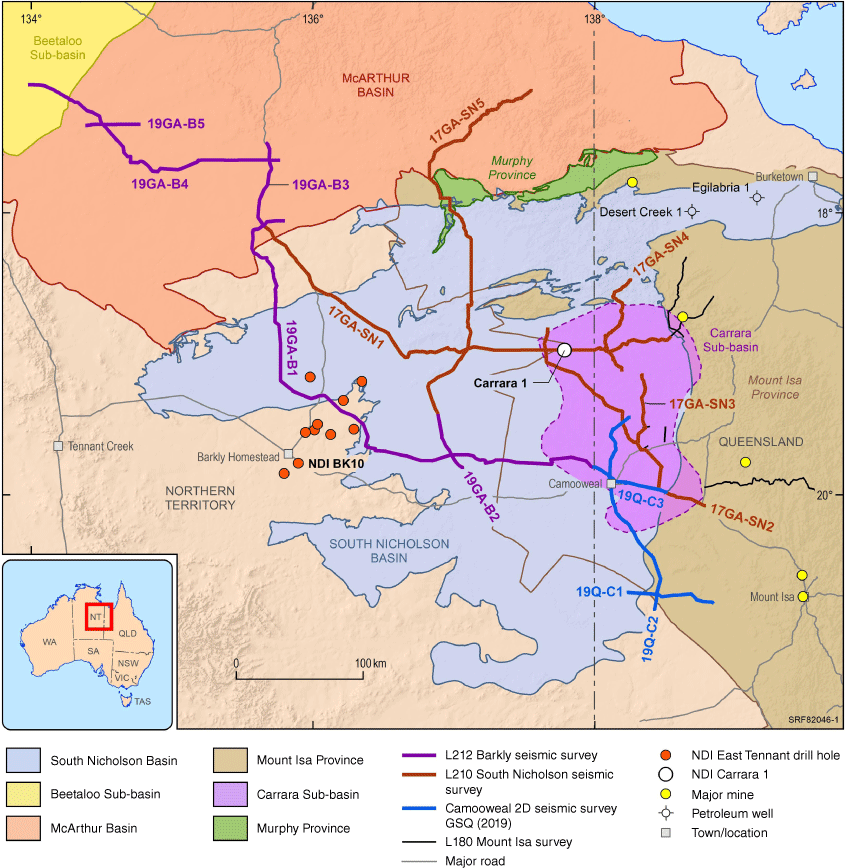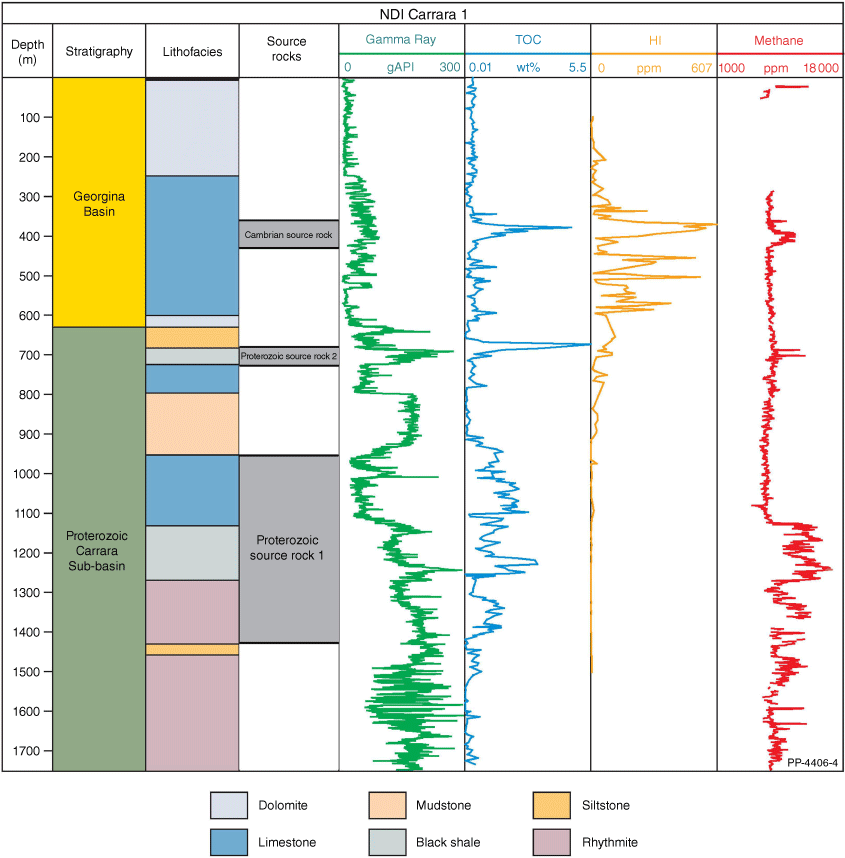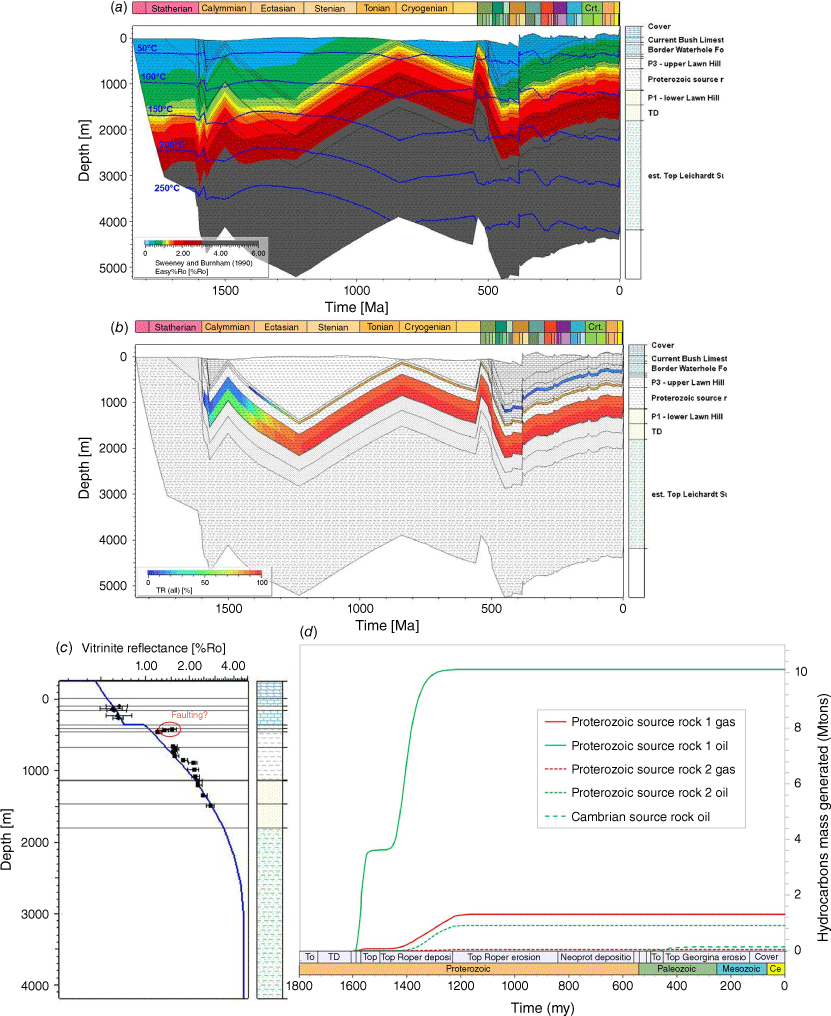Thermal history of the Carrara Sub-basin: insights from modelling of the NDI Carrara 1 drill hole
Tehani J. Palu A * , Emmanuelle Grosjean A , Liuqi Wang A , Christopher J. Boreham A and Adam H. E. Bailey AA Geoscience Australia, Canberra, ACT, Australia.
The APPEA Journal 63 S263-S268 https://doi.org/10.1071/AJ22048
Accepted: 22 February 2023 Published: 11 May 2023
© 2023 The Author(s) (or their employer(s)). Published by CSIRO Publishing on behalf of APPEA. This is an open access article distributed under the Creative Commons Attribution 4.0 International License (CC BY)
Abstract
NDI Carrara 1 is a 1751 m stratigraphic drill hole completed in 2020 as part of the MinEx CRC National Drilling Initiative, in collaboration with Geoscience Australia and Northern Territory Geological Survey under the Exploring for the Future program. It is the first stratigraphic test of the Carrara Sub-basin, a recently discovered depocentre in the South Nicholson region. The drill hole intersected Cambrian and Proterozoic sediments consisting of organic-rich black shales and a thick sequence of interbedded black shales and silty-sandstones with hydrocarbon shows. A comprehensive analytical program carried out by Geoscience Australia on the recovered continuous core from 283 m to total depth at 1751 m provides critical data for understanding this area. Using data from this drilling campaign, thermal history modelling was undertaken to provide an estimate of the time-temperature maxima that the sub-basin has experienced, contributing to an understanding of hydrocarbon maturity. Kerogen kinetics are used to estimate the petroleum prospectivity of the sub-basin and attempt to understand the timing and nature of hydrocarbon generation. Combined, these newly modelled data provide insights into the resource potential of this frontier Proterozoic–Paleozoic hydrocarbon province, delivering foundational data to support explorers across the eastern Northern Territory and northwest Queensland.
Keywords: Carrara Sub-basin, hydrocarbon, MinEx, NDI Carrara 1, Northern Territory, petroleum, petroleum systems modelling, Proterozoic, resource potential, South Nicholson Basin, temperature, thermal history model.
Introduction
The Carrara Sub-basin is a recently discovered depocentre in the South Nicholson region of the Northern Territory and northwestern Queensland which was revealed following the interpretation of new seismic data (Carr et al. 2019) acquired as part of the Exploring for the Future (EFTF) program (Fig. 1). In order to provide stratigraphic control for the imaged sub-surface geology, the NDI Carrara 1 drill hole was completed on the western flanks of the Carrara Sub-basin as part of the MinEx CRC National Drilling Initiative (NDI), in collaboration with Geoscience Australia and the Northern Territory Geological Survey. The drill hole intersected Cambrian and Proterozoic sediments with oil and gas shows, organic-rich black shales and a thick sequence of interbedded black shales and silty-sandstones. Geochemical analyses of rocks and mud gas samples indicate good source rock presence and the potential for an unconventional shale gas play (Grosjean et al. 2022a). This study uses 1D burial and thermal history modelling for the NDI Carrara 1 drill hole, combined with proxy kerogen kinetics to estimate the time-temperature maxima that the Carrara Sub-basin has experienced, and understand the timing and nature of hydrocarbon generation.
Location map of Carrara Sub-basin and NDI Carrara 1, location of new seismic lines and location of northern Lawn Hill Platform modelled wells Desert Creek 1 and Egilabria 1 used as analogues for model inputs for this study (modified from Grosjean et al. 2022b).

Burial and thermal history modelling
A 1D burial and thermal history model was constructed for the NDI Carrara 1 drill hole using interpreted data from the drilling campaign (Geoscience Australia 2021). Age information was assigned based on recently acquired SHRIMP zircon U-Pb geochronology (Kositcin and Carson 2022), and formation picks and lithology information were assigned based on chemostratigraphy and well log analysis (Bailey et al. 2022). The amount of uplift and erosion was estimated through analysis of newly acquired seismic data (Carr et al. 2019) and calibrated using equivalent vitrinite reflectance calculated from bitumen reflectance data (Ranasinghe and Crosdale 2022). Boundary conditions were assigned using an estimated paleo-water depth ranging between −200 m below present-day sea level and up to its current elevation of 262.4 m, and approximated using depositional environments as a guide.
Source rocks
Rock-Eval pyrolysis and organic maceral analysis on samples are reported in Ranasinghe and Crosdale (2022). These data indicate three potential source rocks as follows:
Cambrian source rocks
For Cambrian rocks between the depths 360 and 425 m, TOC (total organic carbon) contents ranged from 0.1% to 4.7% with a mean of 0.5% and hydrogen index (HI) values greater than 300 mg HC/g TOC, indicating a type II kerogen, resulting in fair to excellent potential for oil generation (Grosjean et al. 2022a).
Proterozoic source rocks
Two organic-rich sections are identified within the Proterozoic sedimentary package (Grosjean et al. 2022b);
Between 680 and 725 m, the median TOC content and median HI were 1.4% and 84 mg HC/g TOC, respectively. Without access to immature rock samples, the original HI (HIo) is estimated to be have been 600 mg HC/g TOC based on the assumption of a type II kerogen. This kerogen type is consistent with a marine depositional environment (Crombez et al. 2022). Original TOC is assumed to be 2.25%, after accounting for lost TOC through maturation. This interval will be referred to as Proterozoic source rock 2 (Fig. 2).
Between 950 and 1415 m, the mean TOC content was 1.53% with values up to 3.2%, however, HI contents were low with a mean of only 2 mg HC/g TOC indicating no present-day hydrocarbon-generating potential. These poor generative potentials result from high levels of thermal maturity, which is corroborated by this modelling study. Similarly to the shallower Proterozoic interval, HIo was estimated to be 600 mg HC/g TOC, with an original TOC of 2.04% used for timing of generation modelling. This interval is referred to as Proterozoic source rock 1 (Fig. 2). This sedimentary package is identified as a potential shale gas play (Grosjean et al. 2022b).
NDI Carrara 1 composite log illustrating measured depth, basic stratigraphy, lithology, source rocks, logged total organic carbon (TOC; wt.%), hydrogen index (HI; mg HC/g TOC) and methane concentrations from mud gas logging (modified from Grosjean et al. 2022b).

These three source rock intervals have been included in the thermal model as separate units to determine their timing of generation and to compare their potential (Fig. 3).
Modelling results for NDI Carrara 1 including; (a) burial/thermal history with modelled temperatures indicated with solid blue iso-lines, (b) Transformation ratio history for the three modelled source rocks only, (c) Vr(equivalent) model and calibration data and, (d) estimated timing of generation for the three source rocks.

Maturation and generation
The 1D thermal history model was integrated with source rock property characteristics for the three source rock intervals to understand the maturation process and generative potential for the NDI Carrara 1 drill hole. Thermal boundary conditions were modelled as transient heat flow from base lithosphere at 1330°C. Crustal thickness and radiogenic heat production properties were estimated from northern Lawn Hill Platform well modelling (Desert Creek 1 and Egilabria 1; Palu et al. 2020; Fig. 1), and then adjusted as needed using the calibration data.
Burial and thermal history modelling results for the NDI Carrara 1 drill hole are shown in Fig. 3a. Overall, the model fits well with calibration data, although some of the maturity calibration data may be affected by faulting (Fig. 3c). Fig. 3d shows the timing of hydrocarbon generation. Results show that Proterozoic sediments reached generative potential fairly early, with Proterozoic source rock 1 generating hydrocarbons from ~1588 Ma, with a pause in generation between ~1570 and ~1460 Ma, then reaching full generation by about 1220 Ma. Transformation ratios show full transformation of organic matter (Fig. 3b). Proterozoic source rock 2 began expelling hydrocarbons at about 1400 Ma, reaching a maximum at about 1200 Ma and reaching a transformation ratio of about 80%. The Cambrian source rock is still in its very early stages of generating oil, which is modelled to have begun at about 450 Ma, and has not yet expelled significant hydrocarbons at present-day. The amounts of hydrocarbons generated shown in Fig. 3d are dependent on the makeup of kerogen, which for this modelling study used a type II kerogen.
According to these results, Proterozoic source rock 1 is in the dry gas to late dry gas phase. All hydrocarbons have been generated and any remaining hydrocarbons in the rock would be gas if preservation conditions are favourable, (e.g. shale gas) due to the maturity and age of the kerogens and secondary cracking of oil to gas. Proterozoic source rock 2 is in the rich wet gas to wet gas phase and still has some generation potential. The Cambrian source rock is in the early oil window and is in early stages of generation, and is unlikely to have expelled significant amounts at present-day. Due to the marginal location of the NDI Carrara 1 drill hole, the Proterozoic 2 and Cambrian source rocks may have experienced more generative potentials in the thicker parts of the basin where these source units have been more deeply buried, and may offer even more enhanced prospectivity within the sub-basin.
Conclusions and future work
Although overmature and lacking any remaining hydrocarbon-generating potential, organic-rich Paleoproterozoic source rock 1 (950–1415 m) shows high gas content through most of the section and may represent an unconventional gas play (Grosjean et al. 2022b). Paleoproterozoic source rock 2 (680–725 m) is in a gas phase of maturity and may have remaining hydrocarbon generation potential. The Cambrian source rock (360–425 m) is in an early oil phase and is only just entering a phase of hydrocarbon generation at present-day, however may be further developed within the sub-basin where burial depths are deeper.
Oil is the predominant type of generated hydrocarbon, however the majority of this oil has most likely experienced secondary cracking and any remaining hydrocarbon potential would be in a gaseous state.
Modelling uncertainties for this frontier area are large and future work should focus on understanding the basin history, uplift and erosion analysis, and mapping out the Carrara Sub-basin in more detail using seismic data. Developing a 2D model of the sub-basin along the newly acquired seismic line would be a good next step in understanding where potential source areas could be, and understanding migration pathways for expelled hydrocarbons.
Data availability
The data that support this study are available in the article and accompanying online material accessible via https://www.eftf.ga.gov.au/south-nicholson-national-drilling-initiative.
Acknowledgements
Thanks to Jade Anderson and Chris Nicholson for their peer review. Thanks also go to Chris Carson and Lidena Carr for project support. This paper is published with the permission of the CEO, Geoscience Australia.
References
Bailey AHE, Wang L, Grosjean E, Carson CJ, Butcher G, Jarrett AJ, Henson P (2022) New geomechanical and petrophysical data from NDI Carrara 1; implications for Carrara Sub-basin unconventional prospectivity. In ‘Central Australian Basins Symposium IV (CABS IV) proceedings’, 29–30 August 2022, Darwin, NT. (Northern Territory Geological Survey)Carr LK, Southby C, Henson P, Costelloe R, Anderson JR, Jarrett AJM, Carson CJ, MacFarlane SK, Gorton J, Hutton L, Troup A, Williams B, Khider K, Bailey AHE, Fomin T (2019) ‘Exploring for the Future: South Nicholson Basin Geological summary and seismic data interpretation’. Record 2019/21. (Geoscience Australia: Canberra)
| Crossref |
Crombez V, Delle Piane C, Dewhurst DN (2022) ‘NDI Carrara 1 sedimentology, microstructural analyses, and sequence stratigraphy.’ (Geoscience Australia: Canberra)
| Crossref |
Geoscience Australia (2021) Borehole Completion Report - NDI Carrara 1. Available at https://portal.ga.gov.au/bhcr/minerals/648482
Grosjean E, Boreham CJ, Butcher G, Jarrett A, Long I, Jinadasa N, Webster T, Hong Z (2022a) ‘Exploring for the Future - Rock-Eval pyrolysis data from kerogens of NDI Carrara 1, South Nicholson region, Australia’. Destructive Analysis Report. (Geoscience Australia: Canberra)
| Crossref |
Grosjean E, Jarrett A, Boreham C, Butcher G, Carson C, Bailey A, Wang L, Munson TJ, Henson P (2022b) ‘The energy resource potential of the Carrara Sub-basin revealed by new stratigraphic drilling.’ (Geoscience Australia: Canberra)
| Crossref |
Kositcin N, Carson C (2022) ‘Exploring for the Future – SHRIMP U–Pb geochronology of NDI Carrara 1, South Nicholson region, Northern Territory’. Record 2022/042. (Geoscience Australia: Canberra)
| Crossref |
Palu TJ, Jarrett AJM, Orr ML, Bradshaw BE, Hall LS, Boreham CJ, MacFarlane S (2020) ‘Burial and thermal history analysis of the northern Lawn Hill Platform, Isa Superbasin, Part A’. Record 2020/038. (Geoscience Australia: Canberra)
| Crossref |
Ranasinghe SP, Crosdale PJ (2022) ‘Source rock type, maturation levels and hydrocarbon potential of a suite of samples from NDI Carrara 1 well, Northern Territory.’ (Geoscience Australia: Canberra)
| Crossref |

Tehani J. Palu (nee Kuske) holds a Masters in Earth Science with first class honours from the University of Waikato, New Zealand, and has been with Geoscience Australia since 2009. Tehani has been a Petroleum Systems Analyst in the Onshore Energy Systems team since 2014 at Geoscience Australia after working on several other related projects including carbon capture and storage monitoring and offshore acreage release. |

Emmanuelle Grosjean is an Organic Geochemist at Geoscience Australia working in the Minerals, Energy and Groundwater Division. Emmanuelle applies organic geochemistry to assess the hydrocarbon prospectivity of Australia’s offshore and onshore sedimentary basins. Emmanuelle holds a Doctorate Degree in Organic Chemistry from the University of Strasbourg, France. Emmanuelle joined Geoscience Australia in 2005. |

Liuqi Wang is a Well Analyst at Geoscience Australia working in the Minerals, Energy and Groundwater Division. He received his PhD in Petroleum Engineering and worked as a research fellow at the University of New South Wales before joining Geoscience Australia. His research interests include petrophysics, static and dynamic reservoir modelling, applied statistics and artificial intelligence. |

Christopher J. Boreham is a Principal Petroleum Geochemist at Geoscience Australia working in the Minerals, Energy and Groundwater Division. He obtained his BSc (Hons) in Chemistry from the University of Queensland and was awarded a PhD in Chemistry at ANU. Chris has a wide experience in the application of organic geochemistry to the evolution of oil and gas in Australian sedimentary basins. In 2010 he received the Australian Organic Geochemistry Conference Medal for lifetime achievement in the field of Organic Geochemistry. |

Adam H.E. Bailey is a Petroleum Geoscientist at Geoscience Australia, with expertise in petroleum geomechanics, structural geology and basin analysis. He graduated with a BSc (Hons) in 2012 and a PhD in 2016 from the Australian School of Petroleum at the University of Adelaide. Working with the Onshore Energy Systems team at Geoscience Australia, Adam is currently working on the Exploring for the Future Program. |


